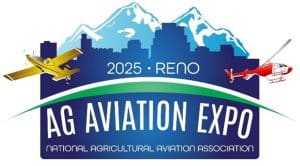Click on the article title below to be taken directly to the article. After you’re done reading the article, click “Back to Top” at the bottom to be brought back to the Table of Contents.
Table of Contents
- NAAREF Hosts Fifth In-Season Safety Session; A Must Listen for All Ag Pilots—Session Recording Available on NAAA Education Center
- Make America Healthy Again Commission Releases Childhood Chronic Diseases Assessments with References to Pesticides
- Bill Lockwood, Longtime Ag Pilot from the Pacific Northwest and Former NAAA Board Member, Passes
- Attention Exhibitors! Large Booth Sales Open for the 2025 Ag Aviation Expo
NAAREF Hosts Fifth In-Season Safety Session; A Must Listen for All Ag Pilots—Session Recording Available on NAAA Education Center

On Tuesday evening NAAREF hosted its fifth annual in-season safety session. The PAASS presenter panelists included ag pilots Rod Thomas of Idaho and NAAREF president, Sam Styron of Missouri, Brian Rau of North Dakota, and Eric Klindt of Minnesota. The session was opened and closed by NAAREF Executive Director Andrew Moore. Moore started the session off by introducing all the panelists and discussing the purpose of the in-season safety session – to have a safety reset in order to bring the focus back to safety for all ag pilots as the busiest part of the season begins.
Moore handed it over to Thomas, who brought up the importance of saying no in aviation. Operators need to give their pilots and ground crew the right to say no when they feel something is not right, or if a part of the job is beyond their skill level. Don’t put yourself in the position of accepting jobs you would otherwise turn down for safety reasons because you’re worried about finances. Rod also brought up the new NAAA Flight Risk Assessment Tool (FRAT) and how it can be used to keep safety in mind by going through a quick checklist before every flight.
Next to speak was Brian Rau who reminded everyone about the importance of keeping wires in the forefront of your mind. Brian talks to himself out loud before each pass about the wires and other obstructions he’ll face in the upcoming pass. He also talked about landing with a load, which he was forced to do so already this season. Ag pilots can watch a video on how to safely land with a load on the NAAA Education Center.
Eric Klindt talked next about being extra cautious when you have low time in type for the aircraft you’re flying, which PAASS has frequently stated is less than 500 hours. In Eric’s case, having a new GPS he was not familiar with caused substantial change and reduced his comfort level in the cockpit, even though he had far more than 500 hours in the aircraft itself. Eric also relayed a personal story about the importance of keeping your cockpit clean and organized.
Sam Styron talked about the layers of distraction that can lead to an accident. Getting distracted in the cockpit can be easy – you can start thinking about customers, weather, and other issues. Pilots need to stay focused on the job at hand and not let this happen. This is important for avoiding CFIT accidents because if your attention is diverted to something other than the job at hand, you may not conduct a proper reconnaissance for wires, towers, and other obstructions.
Moore closed the session by thanking everyone for attending, wishing them a safe and productive season, and reminding everyone a recording of the safety session will be available on NAAA’s Education Center and to share it with ag pilots. He also mentioned the plethora of ag aviation safety materials available on the Education tab of the NAAA website. To view the recording of the safety session, click here.
Make America Healthy Again Commission Releases Childhood Chronic Diseases Assessments with References to Pesticides
Last Thursday, the Make America Healthy Again Commission (MAHA), a presidential advisory body focused on childhood chronic diseases in the U.S., released its initial assessment. To read the report click here. The hastily constructed, equivocal assessment was awaited with concern by the agricultural community due to past critical statements made by and advocacy against pesticides from MAHA chair, U.S. Department of Health and Human Services (HHS) Secretary, Robert F. Kennedy Jr. Some of the areas referencing pesticides in the report are as follows:
- Links childhood exposure to household pesticide exposures (rather than food). “90% [of U.S. homes] showed measurable levels of at least one insecticide on their floors.” In terms of household exposures associated with chemicals, lawn care and indoor exposures, including “dust” and “household sprays” are cited.
- Recognition of farmers. Page 42-43 is the largest section on crop pesticides in the assessment, stating that pesticide exposures in food are safe and there is no direct link between herbicide use and adverse health outcomes, then stating that farmers are essential and U.S. agencies are committed to assisting US farmers.
- States that studies funded by pesticide companies are biased and the U.S. needs more government (non-industry) funded research.
- Chemicals are mentioned by name, including pesticides such as atrazine and glyphosate, “common exposures include lawn care, farming, and pesticide residues.”
- Industry lobbying: The report highlights concerns with industry lobbying and industry’s ability to fund biased research.
Many of the claims made in the assessment are correlative in nature rather than causative, or are tangential, equivocal or seriously antiquated. For example, on page 38, the assessment cites a 1982 study on insecticide residues in breast milk, despite the fact that most of the chemicals referenced have been banned or strictly regulated in these more than four decades. Another one of the studies the MAHA Commission report relied on to raise concerns with glyphosate was thrown out of court by a U.S. District Court judge because, according to the judge, the study’s author, Dr. Luopin Zhang’s “meta-analysis is junk science. It has deep methodological problems, not the least of which is that it doesn’t achieve its stated aim of examining only “highly exposed” individuals. Instead, it examines an arbitrary selection of the available data.” The court order may be found by clicking here.
In response to the release of the report, the Chairs of the House and Senate Agriculture Committees released a joint statement about the report, stating that they are “troubled by the initial findings of the MAHA Commission Assessment and their impact on America’s farmers and ranchers.” Their statement can be found here.
A number of the major national agricultural organizations in the U.S. were critical of the report. The American Soybean Association rebuked the report “for being brazenly unscientific and damaging to consumer confidence in America’s safe, reliable food system. Should the administration act on the report—which was drafted entirely behind closed doors—it will harm U.S. farmers, increase food costs for consumers, and worsen health outcomes for all Americans.” It called on President Trump, “who has long been a friend of farmers, to step in and correct the Commission’s deeply misguided report.” The National Corn Growers Association stated the “report is filled with fear-based rather than science-based information about pesticides.” The National Association of Wheat Growers “urge[d] the Trump administration to ensure that the MAHA Commission’s future work is guided by sound science and peer-reviewed research. American consumers deserve facts—not fear—when it comes to how their food is grown and produced.” The National Cotton Council was “disappointed with the Make America Healthy Again Commission’s report. Over the decades, the Environmental Protection Agency has subjected pesticides to rigorous review and eliminated those that were deemed unsafe. Our current products have been tested and re-tested to protect the farmer, the environment, and the consumer.” The American Farm Bureau Federation stated that “It is deeply troubling for the White House to endorse a report that sows seeds of doubt and fear about our food system and farming practices, then attempts to celebrate farmers and the critical role they play in producing the safest food supply in the world.”
There are also areas of opportunity outlined in the report, including:
- A focus on specialty crops as a way to improve childhood health: Page 30 states, “government programs…to improve children’s nutrition and access to food…much less support for specialty crops such as fruits, vegetables, tree nuts, and nursery plants.”
- Support for the use of chemicals broadly as important tools: Page 35 states, “It is critical to recognize that chemicals are important tools that are inextricably linked to economic growth and innovation, helping feed…every American and maintain food safety standards.”
- Mention of the importance of the U.S. regulatory system where on page 36 the assessment states, “The US government is committed to fostering…gold-standard science to better understand the potential cumulative impacts of environmental exposures [to pesticides]…This cannot happen through a European regulatory system that stifles growth…it will happen through renewed focus on…science throughout the federal government.” The report also references the role of EPA: as having a robust risk-based approach that takes into account hazard and exposure for assessing the risks of chemicals, including pesticides, to human health and the environment.
Other areas the report mentions as factors contributing to childhood health include the following:
- Per- and polyfluoroalkyl substances (PFAS)
- Pharmaceuticals
- Social media use
- Ultra-processed foods
- Vaccines
The MAHA initial assessment report did not prescribe any regulatory actions or policies, however it is currently developing a “Make Our Children Healthy Again Strategy” that is due August 12, 2025
Bill Lockwood, Longtime Ag Pilot from the Pacific Northwest and Former NAAA Board Member, Passes

Bill Lockwood, a longtime agricultural aviator, passed away on May 15, 2025. He was a proud member of NAAA and NAAA board member, serving as Treasurer in 2003. Bill was a member of the Pacific Northwest Aerial Applicators Alliance (PNWAAA) for decades and served as President in 2008 and 2009. In 2009, he received PNWAAA’s Operator of the Year award.
In his teenage years, Bill became an Eagle Scout, following in the footsteps of his father and grandfather. He attended the University of Washington and earned a Bachelor of Arts degree in Business Administration in 1968. During college, he served in the Reserve Officers’ Training Corps (ROTC) and then spent two years as a Lieutenant in the United States Army, including one year in Vietnam.
Bill received early flying instruction from his father, Al, who was a commercial pilot, instructor, and an ag pilot. Bill earned his private pilot’s license at the age of 16 and pursued the profession of flying for the rest of his life, even building his own private airfield near his home in Okanogan for his flying business.
He married Donita Hendrickson Lockwood in 1982, and together they raised two daughters, built their home in 1987, operated his aerial application business, farmed apple and cherry orchards, and raised registered Vizsla bird dogs.
In 2024, Bill received the Wright Brothers Master Pilot Award from the Federal Aviation Administration (FAA).
A celebration of life will be held on May 31, 2025, at 12 p.m. at the United Protestant Church in Mansfield, WA. Donations may be made in Bill’s name to the following organizations:
- PNWAAA, Fallen Pilot Fund, PO Box 55, Quincy, WA 98848
- Mansfield Volunteer Ambulance, PO Box 326, Mansfield, WA 98830
- Mississippi Ag Museum, 1150 Lakeland Dr., Jackson, MS 39216 (please note that the donation is designated for the Ag Aviation Museum).
Our deepest condolences to Donita, Bill’s daughters Abbie and Cathy, and his family and friends. Bill’s obituary can be read here.
Attention Exhibitors! Large Booth Sales Open for the 2025 Ag Aviation Expo

Join us for the 2025 Ag Aviation Expo in Reno, Nov. 17-19. In addition to attending the NAAA Ag Aviation Expo, explore Reno. The city is a fast-growing city that offers numerous dining and libation options. The Midtown District is home to many local bars with live music, offering local artists’ murals and each offers a unique atmosphere. For naturalists and skiers, nearby Lake Tahoe is well worth a trip. Explore the area at www.visitrenotahoe.com.
Booth Sales for Aircraft & Large Booth Space Now Open: If you plan to bring an aircraft, need a 20’x20’+ island booth, a 10’x30’+ inline booth or plan to be a Diamond or Platinum sponsor, please contact Lindsay Barber ASAP. To ensure the best placement on the trade show floor, we would appreciate knowing about aircraft and large booth spaces by early May. 10×10 and 10×20 booth space sales will begin on July 10 at 12 p.m. ET.
The NAAA Trade Show will take place Nov. 18, 12 p.m.–5:30 p.m. and Nov. 19, 9:30 a.m.–3:30 p.m. Review the NAAA Exhibitor Prospectus and exhibitor webpage for further details and pricing here. The full schedule of events is available here.
In Case You Missed Last Week’s NAAA eNewsletter
Click here for the May 22, 2025 eNewsletter to read:
- VAI Features PAASS’ Fly Safe Message About the Newly Released FRAT in Daily eNewsletter
- Cindy Schreiber-Beck, Ag Aviation Industry Icon, North Dakota AAA Executive Director, Passes
- Important Tools Available to Support Health and Environmental Benefits of Pesticides in Light of Upcoming Make America Healthy Again Commission Report, Due for Release This Week
- NAAREF to Host Fifth Annual In-Season Safety Session on May 27th; Register in Advance

